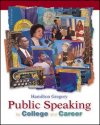Visual aids can enrich and enliven your speech in many ways: They can make
your ideas clear and understandable; make your speech more interesting and memorable;
help an audience remember facts and details; make long, complicated explanations
unnecessary; help prove a point; add to your credibility; and enhance communication
with people who speak English as a second language. The major types of visual aids include graphs, charts, drawings, photographs,
videotape and DVD, computer and Internet multimedia, objects, models, yourself,
and volunteers. They can be conveyed to the audience via various media: electronic
presentations, boards, posters, flip charts, handouts, overhead transparencies,
slides, television, and video projectors. Guidelines for using visual aids: (1) Choose visual aids that truly support
your speech.
(2) Appeal to as many senses as possible. (3) Prepare and practice far in advance.
(4) Don't use too many visuals. (5) Make your aids as simple and clear as possible.
(6) Aim for comprehension by everyone, including the people in the back row.
(7) Never circulate a visual aid among the audience. (8) Remove physical barriers
so that everyone has an unimpeded view. (9) Explain each aid, regardless of
how simple it is. (10) Decide on the best time to show visuals. (11) Make sure
the aids don't distract from your message: Show just one visual at a time, beware
of using animals or children, and watch for misspelled words. (12) Don't talk
to your aids. (13) Use progressive revelation. (14) Plan how you would handle
equipment failure and other emergencies. |



 2002 McGraw-Hill Higher Education
2002 McGraw-Hill Higher Education